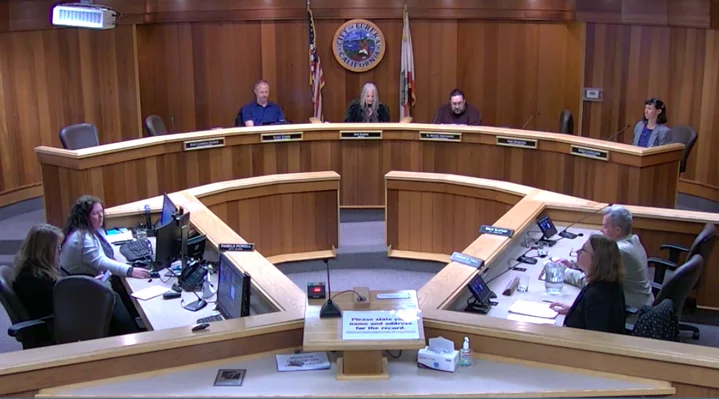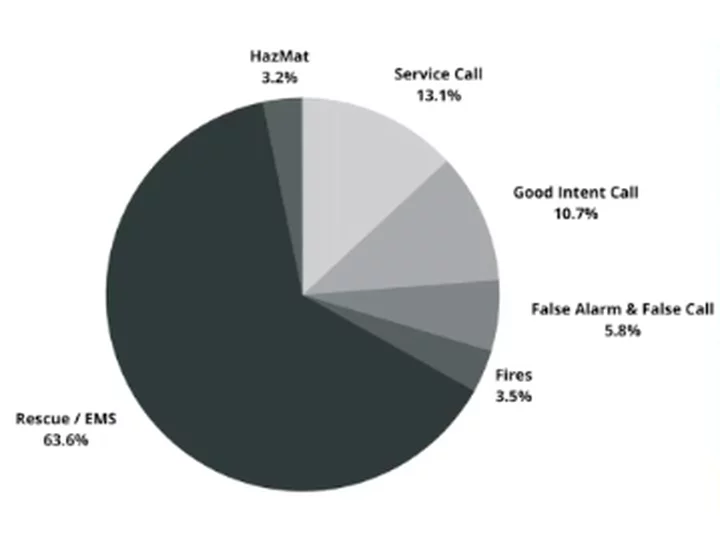Screenshot of Tuesday’s Eureka City Council meeting.
###
Rising interest rates and building costs are complicating efforts to bolster Eureka’s affordable housing stock. In an effort to ease that burden, the Eureka City Council approved a request from staff to submit an application for additional funding through the California Department of Housing and Community Development’s Permanent Local Housing Allocation program.
If approved, the funds would alleviate construction costs for the new senior affordable housing complex being built on Myrtle Avenue. The complex will contain a mix of one-bedroom, two-bedroom and studio apartments for 36 seniors with an income of 60 percent or less than the Area Median Income.
However, the cost of the project has increased significantly since its inception, according to Chris Westlake, a consultant with affordable housing developer and city partner Danco Communities.
“This project is under construction, but due to cost overruns on materials and interest rates, the project [cost] has increased over $2.8 million,” Westlake explained during Tuesday’s council meeting. “In addition, the tax credit pricing was affected before we closed on it. The tax credit application cost another several thousand dollars.”
Danco contacted city staff late last year to look for a way to “bridge some of this gap on the project,” he said. Staff identified a funding source through the state Department of Housing and Community Development and submitted an application. However, the state requires the city council to pass a resolution approving the application request before it can be processed.
Looking beyond the senior housing project, Councilmember Scott Bauer asked if increasing interest rates and material costs will affect the city’s ability to provide housing in the future.
“We’re seeing it statewide,” Westlake said. “You know, for the last couple of years it was rising construction costs. In the last six, eight months it’s now become the interest rates on their construction firm loans, as well as the tax credit pricing. It’s nothing new and … it’s starting to become normal, unfortunately.”
Councilmember Kati Moulton asked if there were any specific projects on the horizon that would be subject to similar financial constraints.
“Not at this time,” said City Manager Miles Slattery. “[Other projects] are in the earlier stages and haven’t even gotten to the point of getting funding. The only other project I can think of that’s not really similar to this is Betty Chinn’s [housing] project [on Hilfiker Lane]. We’ve awarded the [request for proposals] and we’re having discussions with the consultant that received the award and we’re working through those issues. We’re hoping that it is not going to be an issue, but … it is related to the cost of goods that we’re looking at.”
Councilmember Leslie Castellano made a motion to adopt a resolution authorizing the submittal of the funding application. Both Bauer and Moulton offered a second.
Before voting, Castellano noted that “it would be nice if [this item] came to council before it was applied for,” but she was sympathetic to the surrounding circumstance.
“I’m glad to see this particular development moving forward,” she added. “I can’t wait for people to be living in this [complex] after, you know, the many years it’s taken to see it through.”
The council voted 4-0, with Councilmember Renee Contreras de Loach absent, to approve the item.
End of Local COVID Emergency
After nearly three years of living through the pandemic, the council unanimously approved a resolution to terminate the local emergency declaration regarding COVID-19.
The item, which was pulled for discussion from the agenda’s consent calendar, acknowledged that California “has the tools needed to continue fighting COVID-19 when the State of Emergency terminates” on Feb. 28, including “vaccines and boosters, testing, treatments, and other mitigation measures.” While the virus continues to spread, “the conditions necessitating the local emergency due to COVID-19 are steadily improving and … will no longer be warranted,” according to the staff report.
The end of the local state of emergency means the City of Eureka will also terminate its moratorium on water shutoffs, said city Finance Director Lane Millar.
“The good news is, we will give our customers a fresh start,” Millar said. “We will take their current water debt – if they have any – and we will separate that from their utility account so, going forward, they will have at least two billing cycles before any chance of a shutoff. … We will work with customers to the best of our ability to keep people’s water on.”
There are still programs in place for folks struggling to pay delinquent utility bills. There is $15,000 available for utility assistance through the city’s participatory budgeting program, in addition to $200,000 in Community Development Block Grant (CDBG) funds. “That might be a little bit harder [to apply for] than the participatory budget program,” Millar noted. “But I encourage anyone out there to reach out to the city’s finance department to get more information.”
Councilmember G. Mario Fernandez asked how much the city is owed in delinquent utility payments. Millar said the city is owed “roughly a million for both water and sewer,” but noted that the city was already owed around $800,000 before the pandemic.
Castellano made a motion to approve the resolution terminating the local COVID emergency, which was seconded by Bauer.
Before voting, Castellano asked Millar if the staff would consider adding a checklist of some sort to help residents determine if they’re are eligible for utility assistance. Millar said, “Sure, that would be no problem.”
The motion passed unanimously, with Contreras de Loach absent.
Humboldt Bay Fire Update
Last summer, Humboldt Bay Fire Chief Sean Robertson reported a “significant and unprecedented” staffing shortage at the department, forcing the department to implement a temporary rotating closure, or “four-station model,” of one station per day. Humboldt Bay Fire lost 12 employees last year, seven of whom left in a single month.
Fortunately, Robertson said things are looking up. In the last six months, the department has filled all but four positions and is actively recruiting to fill the remaining vacancies.
“We are also modifying our training programs for driver operators and company officers to try to get more of our folks qualified early in their career, and just make it a better development program to have a more long-term solution to this problem,” Robertson said during last night’s meeting. “Our resignations occurred at about every position in the organization. The two resignations we had at the administration level were really significant … and we’re still recovering from that loss [but] we’re thankful for the folks who have joined us.”
Bauer asked if the Humboldt Bay Fire’s response time was impacted by the four-station model. Robertson said it added one to two minutes in additional response time “assuming we’re at the end of a jurisdiction.” The department’s typical response time is between six and seven minutes within the entire jurisdiction, he said.
“Our five stations are strategically located,” he continued. “We have had a Standards of Response Coverage Study to verify that. Our call volume is going to continue to increase with all the tremendous development projects that are happening in the city and in the county. So, maintaining those orientations that are well-vetted are going to stand the test of time, I believe.”
Humboldt Bay Fire’s calls for service in 2022 | Screenshot
Earlier in his presentation, Robertson provided a breakdown of the department’s calls for service and incident types for 2022. Fire-related incidents accounted for 3.5 percent of the department’s calls for service whereas the vast majority of calls – 63.6 percent – were for rescue and emergency medical services. He added that Humboldt Bay Fire’s jurisdiction typically sees more annual fires per capita than the rest of the state.
“I think it’s just our particular demographic and construction features,” he said. “We have a lot of older houses and commercial buildings, whereas a lot of developments and communities in the Bay Area, for example, have a lot of newer construction, they are required to have sprinklers and there’s much more fireproofing. Generally speaking, that would account for some of the differences.”
The council agreed to accept the report but did not take any action on the item.
Zero Waste Action Plan
The council also received an update on the city’s Zero Waste Action Plan. The plan outlines the city’s strategies to maximize recycling while minimizing waste and reducing overall consumption.
Robin Praszker, the city’s environmental project manager, outlined three primary goals listed in the draft document: waste reduction in city offices and facilities, waste reduction for public functions/special events, and leading by example.
“In essence, we’re in this together,” Praszker said. “The first strategy is to invest in city staff education and training [by] setting expectations of waste reduction as a duty of city employees and investing in specific staff who can be leaders. The second strategy is seeking department and community collaborations. … And lastly, to sustain and promote best practices the true effort of leading by example, which means folding in zero waste goals into other city planning documents and asking public officials to serve as role models in zero waste behaviors.”
The first draft of the city’s Zero Waste Plan is nearing completion. It will be presented to the council in the coming months.
The council agreed to accept the report but did not take any formal action on the item.
###
You can find a recording of Tuesday’s meeting here.


CLICK TO MANAGE